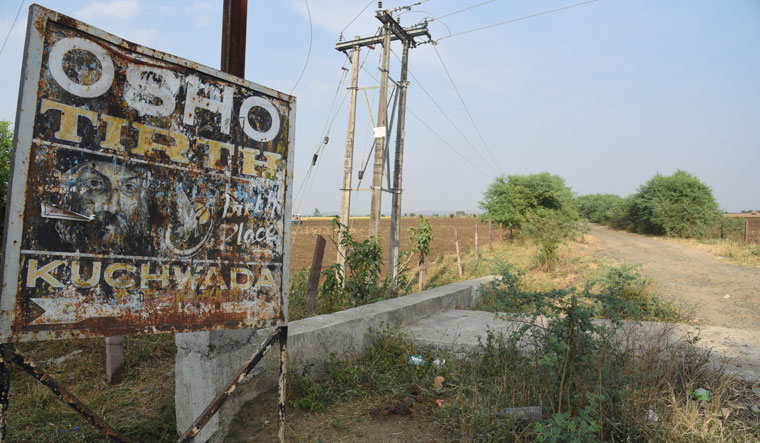“My childhood was certainly golden; not a symbol, absolutely golden; not poetically, but literally, factually,” said Acharya Rajneesh, aka Osho, in a series of talks that were later compiled into the book Glimpses of Golden Childhood in 1998, seven years after he died.
Connecting Osho’s words to Kuchwada, the village in Madhya Pradesh’s Raisen district, is difficult. Leading visitors to this dreary, dusty village is a 4km-long bumpy dirt track. There are no proper roads in Kuchwada, and the nearest railway station is 45km away. As one struggles to steer clear of a stream of sewage that has partly swallowed one of the bylanes, it is hard to meditate on what makes Kuchwada golden.
Osho was born in Kuchwada on December 11, 1931. “My birthplace,” he wrote, “was a village with no railway line and no post office. There was no school, no road.”
True, except that there is a higher secondary school in the village now. It is probably the only big government-initiated change in the village since Osho was born as Chandramohan Jain at his maternal grandparents’ house 89 years ago.
At the centre of the village, and surrounded by the sewage-filled bylane, is an ill-maintained, two-storey house with black wooden doors and a tin roof. That is where the Osho story began. He was born to Saraswati Bai and Babu Lal Jain, in a ground-floor room in the back of the building. Twenty years ago, Osho’s disciples in Japan—led by Swami Satya Tirth, one of his early followers from Ahmedabad—bought the building and erected a metal fence around the compound. Villagers say the followers paid as much as 050 lakh to buy the house. The money appears to have gone now; the building is badly in need of maintenance.
Shivkumar Soni, 63, farmer and goldsmith, said his father, Durgaprasad, and Osho played together when they were children. “Father was two years elder to Osho,” said Soni. Osho and his family left the village when he was seven, and the house was sold off in the 1970s. “We did not see him or even hear of him until Neebuswami (Satya Tirth) bought the house and set up an ashram. But then, too, we did not have much connection with the ashram as those people like to keep to themselves. They charged an entry fee, too,” he said.
Visitors have become rare. “A decade ago, the birth anniversary celebrations attracted many followers, including celebrities like Vinod Khanna,” said Soni. “Last year, though, only 10-15 people turned up.”
The ashram complex has a guest house, a pyramid-shaped meditation hall, and a library (the books were sold off two years ago, say villagers). Satya Tirth had also built a two-storey hospital named after Osho’s maternal grandmother, but it was shut down a year after its opening. “The villagers did not benefit in any way from the activities of the ashram or from the Osho legacy,” said Kuchwada sarpanch Narmada Prasad Lodhi.
Satya Tirth died in January this year. An ashram worker said a Japanese follower of Osho was staying there, but the woman did not want to interact with anyone. Efforts to contact her and other ashram staff were unsuccessful.
Apparently, Osho’s birth anniversary on December 11 may not be celebrated this time. But the villagers are hardly bothered. Saurabh Mirdha, a 15-year-old student, said he neither knew who Osho was, nor was he interested in learning about him and his work. Said Nishant Raghu, a 21-year-old undergraduate: “People tell us that Osho was born here. But I do not know who exactly he was and I did not try to find out, either. He might have been a big man, but his legacy has not helped the village.”
The release of the Netflix documentary Wild Wild Country in 2018 kindled a renewed interest in Osho’s controversial legacy. In November this year, Ma Anand Sheela, who was Osho’s most prominent spokesperson, published her biography By My Own Rules. Kuchwada, however, still remains forgotten.
Swami Narayan, an Osho follower who was close to Satya Tirth, said the situation was “sad”. He had spent time in the Kuchwada ashram from 2005 to 2007. “Swamiji (Satya Tirth) wanted to hand over the management of the hospital to Baba Ramdev’s trust, but could not get a response,” said Narayan. “He also wanted to open a school and had bought a petrol pump to make fuel available at a low price. But he sold it off later.”
He said the ashram in Kuchwada used to be a great place for meditation. “It is sad to hear about its present state. It might be because of pandemic-related issues or other problems,” said Narayan, who has no connections with the Kuchwada ashram now.
Amrit Sadhana, spokesperson for the Osho Commune in Pune, said the Kuchwada ashram does not follow Osho’s rules. “That property was purchased by someone personally and they conduct their affairs in their own way,” she said. “Since they don’t follow the rules of Osho, we cannot have any connection with them.”
When he was alive, Osho had never thought of returning to his village. Now the village, too, would rather forget him. “I have not done anything about that village; I have not even visited it again,” wrote Osho. “Once is enough. I never go to a place twice. For me number two does not exist. I have left many villages, many towns, never to return again. Once gone, gone forever; that’s my way; so I have not returned to that village. The villagers have sent messages to me to come at least once more. I told them, through a messenger, I have been there once already, twice is not my way.”



